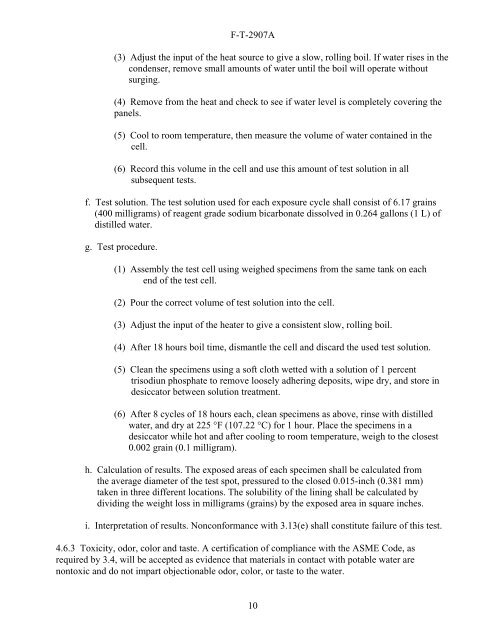F-T-2907A Tanks, Potable Hot Water Storage
F-T-2907A Tanks, Potable Hot Water Storage
F-T-2907A Tanks, Potable Hot Water Storage
You also want an ePaper? Increase the reach of your titles
YUMPU automatically turns print PDFs into web optimized ePapers that Google loves.
F-T-<strong>2907A</strong><br />
(3) Adjust the input of the heat source to give a slow, rolling boil. If water rises in the<br />
condenser, remove small amounts of water until the boil will operate without<br />
surging.<br />
(4) Remove from the heat and check to see if water level is completely covering the<br />
panels.<br />
(5) Cool to room temperature, then measure the volume of water contained in the<br />
cell.<br />
(6) Record this volume in the cell and use this amount of test solution in all<br />
subsequent tests.<br />
f. Test solution. The test solution used for each exposure cycle shall consist of 6.17 grains<br />
(400 milligrams) of reagent grade sodium bicarbonate dissolved in 0.264 gallons (1 L) of<br />
distilled water.<br />
g. Test procedure.<br />
(1) Assembly the test cell using weighed specimens from the same tank on each<br />
end of the test cell.<br />
(2) Pour the correct volume of test solution into the cell.<br />
(3) Adjust the input of the heater to give a consistent slow, rolling boil.<br />
(4) After 18 hours boil time, dismantle the cell and discard the used test solution.<br />
(5) Clean the specimens using a soft cloth wetted with a solution of 1 percent<br />
trisodiun phosphate to remove loosely adhering deposits, wipe dry, and store in<br />
desiccator between solution treatment.<br />
(6) After 8 cycles of 18 hours each, clean specimens as above, rinse with distilled<br />
water, and dry at 225 °F (107.22 °C) for 1 hour. Place the specimens in a<br />
desiccator while hot and after cooling to room temperature, weigh to the closest<br />
0.002 grain (0.1 milligram).<br />
h. Calculation of results. The exposed areas of each specimen shall be calculated from<br />
the average diameter of the test spot, pressured to the closed 0.015-inch (0.381 mm)<br />
taken in three different locations. The solubility of the lining shall be calculated by<br />
dividing the weight loss in milligrams (grains) by the exposed area in square inches.<br />
i. Interpretation of results. Nonconformance with 3.13(e) shall constitute failure of this test.<br />
4.6.3 Toxicity, odor, color and taste. A certification of compliance with the ASME Code, as<br />
required by 3.4, will be accepted as evidence that materials in contact with potable water are<br />
nontoxic and do not impart objectionable odor, color, or taste to the water.<br />
10

















